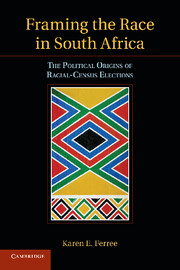Book contents
- Frontmatter
- Contents
- List of Tables
- Acknowledgments
- 1 Introduction
- 2 Voters
- 3 The 1994 Campaigns
- 4 The 1999 Campaigns
- 5 The 2004 Campaigns
- 6 Can a Leopard Change Its Spots? Candidate Demographics and Party Label Change
- 7 Why So Slow? The Political Challenges of Candidate Transformation for Opposition Parties
- 8 Negative Framing Strategies and African Opposition Parties
- 9 Conclusion: South Africa in Comparative Perspective
- References
- Index
- Titles in the series
4 - The 1999 Campaigns
Published online by Cambridge University Press: 06 December 2010
- Frontmatter
- Contents
- List of Tables
- Acknowledgments
- 1 Introduction
- 2 Voters
- 3 The 1994 Campaigns
- 4 The 1999 Campaigns
- 5 The 2004 Campaigns
- 6 Can a Leopard Change Its Spots? Candidate Demographics and Party Label Change
- 7 Why So Slow? The Political Challenges of Candidate Transformation for Opposition Parties
- 8 Negative Framing Strategies and African Opposition Parties
- 9 Conclusion: South Africa in Comparative Perspective
- References
- Index
- Titles in the series
Summary
South Africa held its second post-apartheid elections on June 2, 1999. The African National Congress (ANC) dominated again, winning a healthy 66 percent of the vote. It captured outright seven of the nine provincial legislatures and increased its vote share in KwaZulu-Natal and the Western Cape, winning a plurality in the latter. This time around the ANC's major opponent in the national election was not the National Party (now the New National Party) but the Democratic Party, which took 9.5 percent of the vote. Indeed, the dramatic collapse of the NNP's support (from 20 percent in 1994 to around 7 percent in 1999) was one of the election's most notable departures from 1994. Also significant was the decline of the IFP in KwaZulu-Natal (down from 50.3 to 41.9 percent) and the rise of a new party, the United Democratic Movement, which won around 3 percent of the national vote, most of it concentrated in the Eastern Cape.
Unlike 1994, the 1999 campaigns of the two largest competitors (the ANC and the DP) conformed much more closely to Horowitz's description of “head-count” elections. The ANC focused most of its energy on African, coloured, and Indian voters (by and large ignoring whites). In African constituencies where it lacked a credible African challenger (the IFP or UDM), its campaigns leaned heavily in the direction of mobilization, suggesting that it did not take competition from the DP or NP seriously.
- Type
- Chapter
- Information
- Framing the Race in South AfricaThe Political Origins of Racial Census Elections, pp. 82 - 106Publisher: Cambridge University PressPrint publication year: 2010

